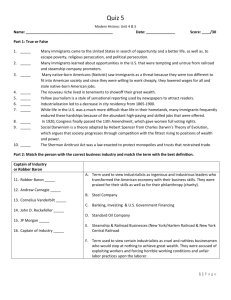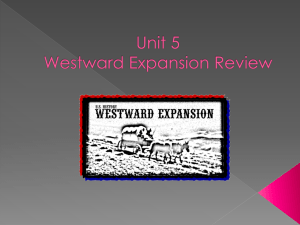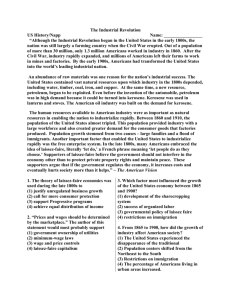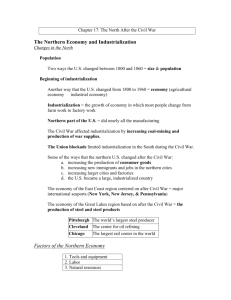Industrialization Test Study Guide
advertisement
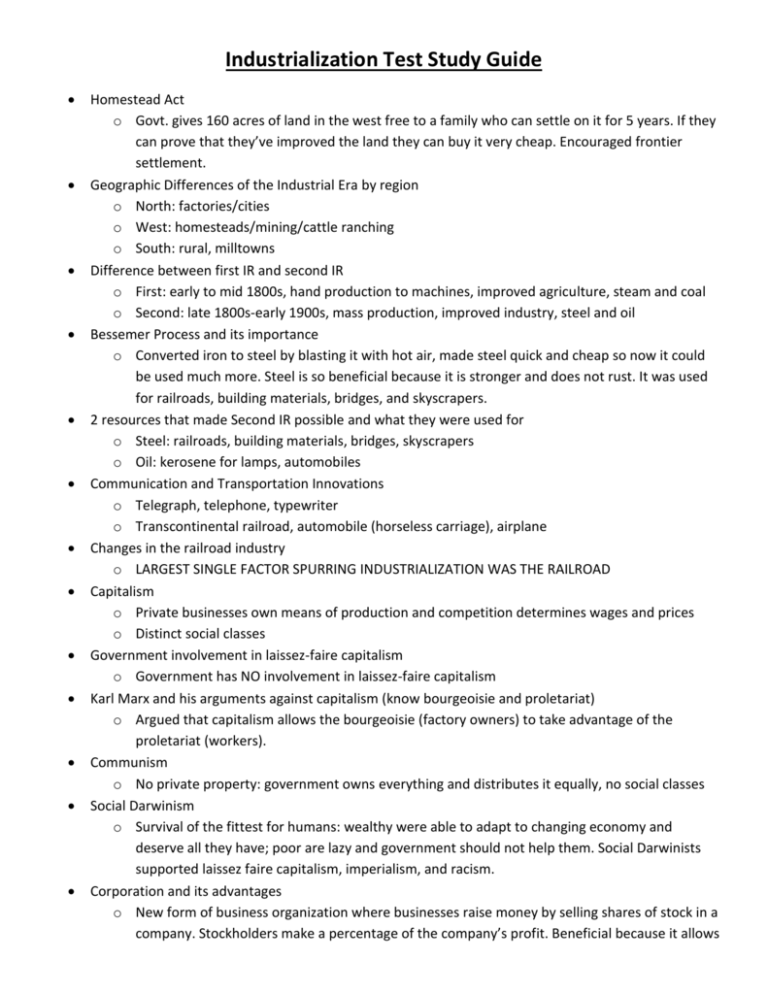
Industrialization Test Study Guide Homestead Act o Govt. gives 160 acres of land in the west free to a family who can settle on it for 5 years. If they can prove that they’ve improved the land they can buy it very cheap. Encouraged frontier settlement. Geographic Differences of the Industrial Era by region o North: factories/cities o West: homesteads/mining/cattle ranching o South: rural, milltowns Difference between first IR and second IR o First: early to mid 1800s, hand production to machines, improved agriculture, steam and coal o Second: late 1800s-early 1900s, mass production, improved industry, steel and oil Bessemer Process and its importance o Converted iron to steel by blasting it with hot air, made steel quick and cheap so now it could be used much more. Steel is so beneficial because it is stronger and does not rust. It was used for railroads, building materials, bridges, and skyscrapers. 2 resources that made Second IR possible and what they were used for o Steel: railroads, building materials, bridges, skyscrapers o Oil: kerosene for lamps, automobiles Communication and Transportation Innovations o Telegraph, telephone, typewriter o Transcontinental railroad, automobile (horseless carriage), airplane Changes in the railroad industry o LARGEST SINGLE FACTOR SPURRING INDUSTRIALIZATION WAS THE RAILROAD Capitalism o Private businesses own means of production and competition determines wages and prices o Distinct social classes Government involvement in laissez-faire capitalism o Government has NO involvement in laissez-faire capitalism Karl Marx and his arguments against capitalism (know bourgeoisie and proletariat) o Argued that capitalism allows the bourgeoisie (factory owners) to take advantage of the proletariat (workers). Communism o No private property: government owns everything and distributes it equally, no social classes Social Darwinism o Survival of the fittest for humans: wealthy were able to adapt to changing economy and deserve all they have; poor are lazy and government should not help them. Social Darwinists supported laissez faire capitalism, imperialism, and racism. Corporation and its advantages o New form of business organization where businesses raise money by selling shares of stock in a company. Stockholders make a percentage of the company’s profit. Beneficial because it allows company to make a lot of money, the stockholders are not responsible for corporation’s debt, and it makes the company much more stable because it is being run by a board of trustees rather than being dependent on one person. Trust and monopoly o Trust: Group of companies turn stock over to common board of trustees who run them as a single business, reduces competition in an industry o Monopoly: when a trust gains exclusive control of an entire industry and thus can make their prices whatever they want. Sherman Anti-Trust Act o Federal government’s first attempt to regulate trusts: failed miserably because Supreme Court will use it to break apart unions of workers rather than breaking apart the trust Vertical integration and horizontal combination o Vertical integration: Company gains control of production at every step of the way. Can make their goods much cheaper than other companies. Example: cattle, slaughterhouse, railroad cars, warehouse, meat packing plant. o Horizontal combination: Gaining control of market for single product (creating a monopoly) Ex: Standard Oil Gospel of Wealth o Created by Andrew Carnegie o Says that IR created social classes and it is responsibility of wealthy to distribute their riches in a way that will improve society rather than simply leaving it all to their children to waste Federal government’s policies concerning big business o All of their policies generally favored big business. o Laissez-faire: they stayed out of economy Be able to discuss new groups of workers and what working conditions were like o Immigrants were the factory workers. Conditions were unhealthy and dangerous. o Meatpacking: unsanitary, chopped off fingers and rats and rat poison in uncleaned meat grinders o Factories: doors would be locked so workers couldn’t take breaks, no bathroom breaks (bucket by your machine), wouldn’t mark high voltage wires, 10-12 hour days, low pay, no fire escapes/extinguishers, no air circulation/open windows, would lose your job if you stayed home because you were sick or injured o Mines: breathing in deadly fumes, cave-ins, dynamite explosions Why did people form labor unions? o To try and improve working conditions, hours, etc. Knights of Labor, American Federation of Labor o Knights of Labor: included skilled and unskilled workers, wanted to overthrow wage system, destroyed by Haymarket Square Bombing o AF of L: only included skilled workers, went along with the wage system, collected dues to pay workers during strikes so they could last longer, most successful union of nineteenth century What were the cities like? o Overcrowded, dirty, unsanitary, factories, smelly, air pollution, garbage, skyscrapers, tenements, subways, criminals Differences between New Immigrants and Old Immigrants o Old: came before 1880, western Europe like Scandinavia and Germany, had high literacy rate, understood representative government, settled on farms o New: came after 1880, southern and eastern Europe like Russia, Italy, Greece and Poland, could not read or write, did not understand representative government, were poor, settled in cities and took factory jobs. Why did new immigrants come? o America fever, job opportunities, religious persecution, overcrowding in Europe How did the government and the American people react to the new immigrants? o Federal government did nothing to help the immigrants. Women set up settlement houses that were like community centers that would teach English, provide childcare, teach skills, help find jobs, plan community activities etc. Anything to help Americans acclimate to American life. Most famous settlement house was Hull House started by Jane Addams. o Local corrupt politicians would find the immigrants housing and jobs in exchange for votes. o Most Americans were nativists: they disliked the immigrants and petitioned the federal government to pass immigration restrictions like the Chinese Exclusion Act. Compare and contrast life for different social classes in cities during the IR o Wealthy: industrialists (robber barons=industrialists who gained their wealth dishonestly or by taking advantage of the workers) 1% of the population. Conspicuous consumption: highly visible displays of wealth (ex=summer homes in Newport Rhode Island, lavish parties for their pets, jewels, furs, latest fashions, dinner parties in front of windows to show off their wealth.) o Middle class: lived in suburbs right outside city and commuted to work. Worked 5 days a week but lived comfortably and made enough to enjoy leisure time. Managers, lawyers, doctors etc. Women were housewives. o Poor: immigrants, lived in tenements in cities, worked all week in dirty factories or if children were too young to work in factories worked out of home Be able to provide examples of the impact of industrialization on the American people o Growth of consumer society o Distinct social classes o Growth of cities o Conversion to wage system and dangerous working conditions o Big businesses have too much power o New culture and belief in the importance of leisure time o Creation of unions o Higher standard of living o Increased life expectancy o Women were the group affected the most by the IR The impact of the Industrial Revolution on education o Education became much more important because the only way to get better paying jobs was to have more education and training. Made high school mandatory for certain number of weeks a year. Encouraged young people to go to college: so many colleges built during the nineteenth century. Colleges also started accepting women. New leisure activities that developed during the Industrial Revolution o Amusement parks like Coney Island o Outdoor activities in parks like Central Park: golf, tennis, cycling, picnics o Baseball became country’s national pastime o Ragtime music became popular o Vaudeville shows: variety shows with singing and dancing o Silent films became popular to go and see Largest single factor spurring industrialization = the railroad


